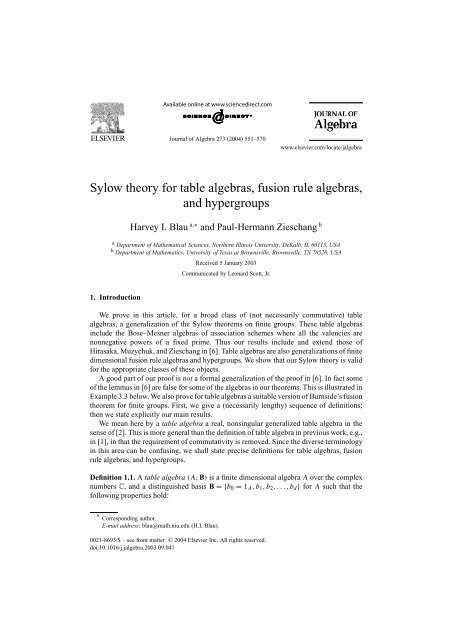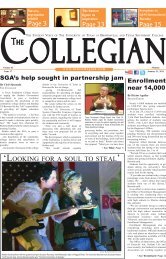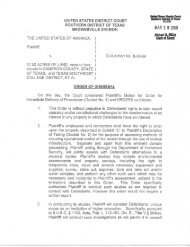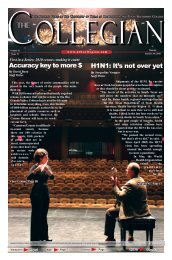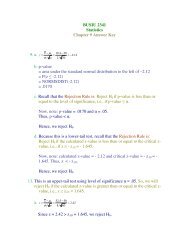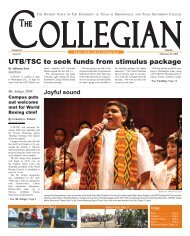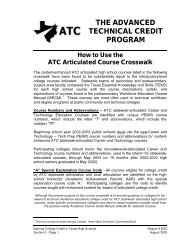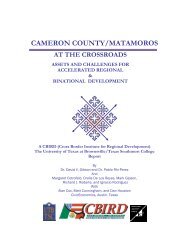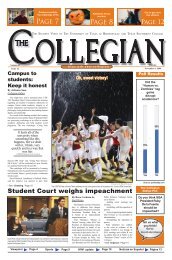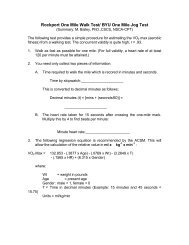Sylow theory for table algebras, fusion rule algebras, and ... - blue
Sylow theory for table algebras, fusion rule algebras, and ... - blue
Sylow theory for table algebras, fusion rule algebras, and ... - blue
Create successful ePaper yourself
Turn your PDF publications into a flip-book with our unique Google optimized e-Paper software.
Journal of Algebra 273 (2004) 551–570<br />
www.elsevier.com/locate/jalgebra<br />
<strong>Sylow</strong> <strong>theory</strong> <strong>for</strong> <strong>table</strong> <strong>algebras</strong>, <strong>fusion</strong> <strong>rule</strong> <strong>algebras</strong>,<br />
<strong>and</strong> hypergroups<br />
Harvey I. Blau a,∗ <strong>and</strong> Paul-Hermann Zieschang b<br />
a Department of Mathematical Sciences, Northern Illinois University, DeKalb, IL 60115, USA<br />
b Department of Mathematics, University of Texas at Brownsville, Brownsville, TX 78520, USA<br />
Received 5 January 2003<br />
Communicated by Leonard Scott, Jr.<br />
1. Introduction<br />
We prove in this article, <strong>for</strong> a broad class of (not necessarily commutative) <strong>table</strong><br />
<strong>algebras</strong>, a generalization of the <strong>Sylow</strong> theorems on finite groups. These <strong>table</strong> <strong>algebras</strong><br />
include the Bose–Mesner <strong>algebras</strong> of association schemes where all the valencies are<br />
nonnegative powers of a fixed prime. Thus our results include <strong>and</strong> extend those of<br />
Hirasaka, Muzychuk, <strong>and</strong> Zieschang in [6]. Table <strong>algebras</strong> are also generalizations of finite<br />
dimensional <strong>fusion</strong> <strong>rule</strong> <strong>algebras</strong> <strong>and</strong> hypergroups. We show that our <strong>Sylow</strong> <strong>theory</strong> is valid<br />
<strong>for</strong> the appropriate classes of these objects.<br />
A good part of our proof is not a <strong>for</strong>mal generalization of the proof in [6]. In fact some<br />
of the lemmas in [6] are false <strong>for</strong> some of the <strong>algebras</strong> in our theorems. This is illustrated in<br />
Example 3.3 below. We also prove <strong>for</strong> <strong>table</strong> <strong>algebras</strong> a sui<strong>table</strong> version of Burnside’s <strong>fusion</strong><br />
theorem <strong>for</strong> finite groups. First, we give a (necessarily lengthy) sequence of definitions;<br />
then we state explicitly our main results.<br />
We mean here by a <strong>table</strong> algebra a real, nonsingular generalized <strong>table</strong> algebra in the<br />
sense of [2]. This is more general than the definition of <strong>table</strong> algebra in previous work, e.g.,<br />
in [1], in that the requirement of commutativity is removed. Since the diverse terminology<br />
in this area can be confusing, we shall state precise definitions <strong>for</strong> <strong>table</strong> <strong>algebras</strong>, <strong>fusion</strong><br />
<strong>rule</strong> <strong>algebras</strong>, <strong>and</strong> hypergroups.<br />
Definition 1.1. A <strong>table</strong> algebra (A, B) is a finite dimensional algebra A over the complex<br />
numbers C, <strong>and</strong> a distinguished basis B ={b0 = 1A,b1,b2,...,bd} <strong>for</strong> A such that the<br />
following properties hold:<br />
* Corresponding author.<br />
E-mail address: blau@math.niu.edu (H.I. Blau).<br />
0021-8693/$ – see front matter © 2004 Elsevier Inc. All rights reserved.<br />
doi:10.1016/j.jalgebra.2003.09.041
552 H.I. Blau, P.-H. Zieschang / Journal of Algebra 273 (2004) 551–570<br />
(1.1a) The structure constants <strong>for</strong> B are nonnegative real numbers; that is, <strong>for</strong> all a,b ∈ B,<br />
ab = <br />
λabcc, <strong>for</strong> some λabc ∈ R + ∪{0}.<br />
c∈B<br />
(1.1b) There is an algebra antiautomorphism (denoted by ∗) ofA such that (a ∗ ) ∗ = a <strong>for</strong><br />
all a ∈ A <strong>and</strong> B ∗ = B.<br />
(1.1c) For all a,b ∈ B, λab1 = 0ifb = a ∗ ;<strong>and</strong>λaa ∗ 1 = λa ∗ a1 > 0.<br />
Remark 1.1. (i) The condition that λaa ∗ 1 = λa ∗ a1 is in fact a consequence of all the other<br />
properties in Definition 1.1. We do not include a proof in this article.<br />
(ii) For any <strong>table</strong> algebra (A, B), Theorem 3.14 of [2] implies that there exists a unique<br />
algebra homomorphism ||: A → C such that |b|=|b ∗ | > 0<strong>for</strong>allb ∈ B. Thevalues|b|,<br />
<strong>for</strong> all b ∈ B, are called the degrees of (A, B).<br />
Definition 1.2. A <strong>table</strong> algebra (A, B) is called st<strong>and</strong>ard if <strong>for</strong> all b ∈ B, |b|=λbb ∗ 1.<br />
Example 1.1. (i) The Bose–Mesner algebra of an association scheme is an example of<br />
a st<strong>and</strong>ard <strong>table</strong> algebra. That is, given an association scheme (in the sense of [10]) on an<br />
underlying set of finite cardinality n, each relation of the scheme is encoded in an n×n 0/1<br />
matrix. The set of these adjacency matrices <strong>for</strong>ms a basis <strong>for</strong> the algebra that it generates,<br />
<strong>and</strong> Definition 1.1 is satisfied, where the antiautomorphism is matrix transpose. The degree<br />
assigned to each adjacency matrix is its (invariant) row sum, which equals the valency of<br />
the corresponding relation.<br />
(ii) Any group of automorphisms F of a finite group G induces a group of<br />
automorphisms on the group algebra CG.Let(CG) F denote the subalgebra of F -invariant<br />
elements. Let B denote the set of sums in CG over the F -orbits of G. Then((CG) F , B)<br />
is a st<strong>and</strong>ard <strong>table</strong> algebra. The antiautomorphism is induced from inversion on G,<strong>and</strong>the<br />
degree of each orbit sum is the cardinality of the orbit.<br />
Note that the <strong>algebras</strong> of Example 1.1 are examples of integral <strong>table</strong> <strong>algebras</strong>. That is,<br />
all of their structure constants <strong>and</strong> (hence, since they are st<strong>and</strong>ard) all of their degrees are<br />
integers.<br />
Remark 1.2. Any <strong>table</strong> algebra (A, B) can be rescaled (as in Section 2 of [1]) to one which<br />
is st<strong>and</strong>ard. Specifically, if B ′ := { |b|<br />
λ b | b ∈ B}, then(A, B<br />
bb∗1 ′ ) is a st<strong>and</strong>ard <strong>table</strong> algebra<br />
(Theorem 3.15 of [2], Theorem 2.10 of [1]).<br />
Definition 1.3. (i) A finite dimensional <strong>fusion</strong> <strong>rule</strong> algebra is a commutative <strong>table</strong> algebra<br />
(A, B) such that each structure constant λabc is an integer <strong>and</strong> λbb ∗ 1 = 1<strong>for</strong>allb ∈ B.(See<br />
[4, pp. 47–48].)<br />
(ii) A finite dimensional hypergroup is a <strong>table</strong> algebra (A, B) such that |b|=1<strong>for</strong>all<br />
b ∈ B. (See [8, p. 69].)
H.I. Blau, P.-H. Zieschang / Journal of Algebra 273 (2004) 551–570 553<br />
Definition 1.4. Let (A, B) be a <strong>table</strong> algebra <strong>and</strong> let S1, S2,...,Sm be nonempty subsets<br />
of B.Define<br />
S1S2 ···Sm :=<br />
<br />
s1∈S1, s2∈S2,...,sm∈Sm<br />
Supp B (s1s2 ···sm).<br />
It follows from associativity of A <strong>and</strong> nonnegativity of the structure constants <strong>for</strong> B<br />
that this set product is associative. That is, (ST)U = S(TU) = STU <strong>for</strong> all S, T, U ⊆ B. If<br />
b,c ∈ B then in particular {b}{c}=Supp B (bc). Forb,c ∈ B <strong>and</strong> S ⊆ B, we write {b}S as<br />
bS, {b}S{c} as bSc, etc.<br />
Definition 1.5. Let (A, B) be a <strong>table</strong> algebra. A nonempty subset C of B is called a closed<br />
subset (or a <strong>table</strong> subset)ofB if C ∗ C ⊆ C.<br />
Remark 1.3. This definition is clearly equivalent to the one given in [2], namely that<br />
C = C ∗ <strong>and</strong> CC ⊆ C. It is also equivalent simply to the condition that CC ⊆ C. (See<br />
Corollary 2.6 below.)<br />
Definition 1.6. Let (A, B) be a <strong>table</strong> algebra.<br />
(i) For each b ∈ B, thes<strong>table</strong> degree of b is defined as<br />
σ(b):= |b|2<br />
λbb∗ .<br />
1<br />
(ii) For any subset S ⊆ B,bytheorder of S we mean<br />
o(S) := <br />
σ(b);<br />
<strong>and</strong> S + is defined as<br />
b∈S<br />
S + := <br />
b.<br />
Remark 1.4. (i) It is immediate that <strong>for</strong> any b ∈ B <strong>and</strong> λ ∈ R + with λb in a rescaling of B,<br />
then σ(λb)= σ(b), so that s<strong>table</strong> degrees, <strong>and</strong> hence order, are invariant under rescaling.<br />
(ii) Note that if (A, B) is st<strong>and</strong>ard then <strong>for</strong> all b ∈ B <strong>and</strong> S ⊆ B, σ(b)=|b|=λbb ∗ 1 <strong>and</strong><br />
o(S) =|S + |.<br />
Definition 1.7. Fix a (rational) prime p. A <strong>table</strong> algebra (A, B) is called p-fractional if <strong>for</strong><br />
all a,b,c ∈ B the structure constant<br />
λabc = n<br />
pm <strong>for</strong> some n, m ∈ Z+ ∪{0} (depending on a,b,c).<br />
b∈S
554 H.I. Blau, P.-H. Zieschang / Journal of Algebra 273 (2004) 551–570<br />
Remark 1.5. Note that all integral <strong>table</strong> <strong>algebras</strong>, <strong>and</strong> in particular the <strong>algebras</strong> of<br />
Example 1.1, are p-fractional <strong>for</strong> all primes p.<br />
Definition 1.8. Fix a prime p.Let(A, B) be a <strong>table</strong> algebra <strong>and</strong> let S ⊆ B.ThenS is called<br />
p-valenced if <strong>for</strong> all b ∈ S, σ(b) is a power of p. Also,S is called a p-subset of B if S is<br />
p-valenced <strong>and</strong> o(S) is a power of p.<br />
Remark 1.6. (i) Note that if B is p-valenced then o(S) ∈ Z + <strong>for</strong> all S ⊆ B.<br />
(ii) If F is a p-group of automorphisms of a finite group G, then each F -orbit of G has<br />
cardinality a power of p. Hence, ((CG) F , B) (as in Example 1.1(ii)) is p-valenced, as well<br />
as p-fractional. In particular, (CG, G) is p-valenced <strong>for</strong> all primes p.<br />
(iii) Fix a prime p <strong>and</strong> let (A, B) be a st<strong>and</strong>ard, p-fractional, p-valenced <strong>table</strong> algebra.<br />
Let C be a closed subset of B. It is not necessarily true that o(C) is a divisor (in Z)ofo(B)<br />
(see Example 3.3 below). However, if C is a closed p-subset of B then in fact o(C) | o(B)<br />
(Lemma 4.1 below), so that o(B)/o(C) ∈ Z + . This prompts the next definition, which<br />
clearly generalizes the notion of a <strong>Sylow</strong> p-subgroup of a finite group. It is modeled after<br />
the definition <strong>for</strong> p-valenced association schemes in [6].<br />
Definition 1.9. Let (A, B) be a st<strong>and</strong>ard, p-fractional, p-valenced <strong>table</strong> algebra. A <strong>Sylow</strong><br />
p-subset of B is a closed p-subset C of B such that p ∤ o(B)/o(C). The family of all <strong>Sylow</strong><br />
p-subsets of B is denoted as Syl p (B).<br />
Definition 1.10. Let (A, B) be a <strong>table</strong> algebra. Subsets S, T of B are called conjugate in B<br />
if there exists some b ∈ B such that bSb ∗ ⊆ T <strong>and</strong> b ∗ Tb ⊆ S.<br />
Remark 1.7. (i) It seems essential to build this symmetry into the definition. If only<br />
bSb ∗ = T were required <strong>for</strong> conjugacy of S <strong>and</strong> T, then{1} would be conjugate to<br />
Supp B (bb ∗ ) <strong>for</strong> all b ∈ B, which clearly would not be a good situation.<br />
(ii) It will follow from Corollary 2.5 below that if bSb ∗ ⊆ T <strong>and</strong> b ∗ Tb ⊆ S then in fact<br />
bSb ∗ = T <strong>and</strong> b ∗ Tb = S. Furthermore, conjugacy is an equivalence relation on the family<br />
of subsets of B.<br />
Definition 1.11. Let (A, B) be a <strong>table</strong> algebra <strong>and</strong> φ = S ⊆ B.<br />
(i) The normalizer of S in B is defined as<br />
NB(S) := b ∈ B | bSb ∗ ⊆ S .<br />
(ii) Let T ⊆ B such that S ⊆ T ⊆ NB(S).ThenS is called a normal subset of T.<br />
Remark 1.8. We show in Corollary 2.7 below that NB(S) is a closed subset of B <strong>and</strong> that<br />
bSb ∗ = S <strong>for</strong> all b ∈ NB(s).<br />
We are finally ready to state the main theorems of this article. According to<br />
Remark 1.6(ii), Theorem 1.1 generalizes the three classical <strong>Sylow</strong> theorems in [9], <strong>and</strong><br />
Theorem 1.2 does the same <strong>for</strong> Burnside’s <strong>fusion</strong> theorem (see Theorem 7.1.1 of [5]).
H.I. Blau, P.-H. Zieschang / Journal of Algebra 273 (2004) 551–570 555<br />
Theorem 1.1. Fix a prime p. Let(A, B) be a st<strong>and</strong>ard, p-fractional, p-valenced <strong>table</strong><br />
algebra. Then the following hold.<br />
(i) If P is a closed p-subset of B <strong>and</strong> P /∈ Syl p (B) then there exists a closed p-subset P ′<br />
of B such that P ⊆ P ′ ⊆ NB(P) <strong>and</strong> o(P ′ ) = p · o(P).<br />
(ii) Any two members of Syl p (B) are conjugate in B.<br />
(iii) The number of distinct <strong>Sylow</strong> p-subsets of B is congruent to 1 modulo p.<br />
Remark 1.9. (i) The proof of Theorem 1.1 uses Cauchy’s theorem (that a group of order<br />
divisible by p contains an element of order p) but does not use the <strong>Sylow</strong> theorems<br />
themselves. So they may be regarded as corollaries of Theorem 1.1.<br />
(ii) Suppose that a <strong>table</strong> algebra (A, B) as in Theorem 1.1 is also commutative. It follows<br />
from Corollary 2.10 below that a <strong>Sylow</strong> p-subset P is conjugate in B only to itself. Hence,<br />
B has a unique <strong>Sylow</strong> p-subset.<br />
Theorem 1.2. Fix a prime p. Let(A, B) be a st<strong>and</strong>ard, p-fractional, p-valenced <strong>table</strong><br />
algebra. Let P ∈ Syl p (B). Then two normal subsets of P are conjugate in B if <strong>and</strong> only if<br />
they are conjugate in NB(P).<br />
Corollary 1.3. Let (A, B) be either a p-valenced <strong>fusion</strong> <strong>rule</strong> algebra, or alternatively<br />
a p-fractional hypergroup in which each structure constant λbb ∗ 1 = p −mb <strong>for</strong> some<br />
mb ∈ Z + ∪{0}. Then its st<strong>and</strong>ard rescaling is a p-valenced <strong>and</strong> p-fractional <strong>table</strong> algebra,<br />
<strong>and</strong> the conclusions of Theorems 1.1 <strong>and</strong> 1.2 hold <strong>for</strong> (A, B).<br />
The following two corollaries are well known results <strong>for</strong> finite groups. We obtain them<br />
as applications of Theorem 1.1.<br />
Corollary 1.4. Fix a prime p. LetH be a subgroup of a finite group G such that <strong>for</strong> all<br />
x ∈ G, |H : H ∩ H x |=p nx <strong>for</strong> some nonnegative integer nx. Then there exists a subgroup<br />
P with H P G <strong>and</strong> such that |P : H |=|G : H |p (the p-part of the index of H in G).<br />
Furthermore, the number of such subgroups P is congruent to 1 modulo p, <strong>and</strong> they are<br />
all conjugate in G.<br />
Corollary 1.5 [7, Theorem 6.9]. Fix a prime p. LetG be a finite group such that the<br />
degree of every irreducible character of G is a nonnegative integer power of p. ThenG<br />
has a normal abelian p-complement.<br />
The rest of the paper is organized as follows. Section 2 recounts some facts about<br />
<strong>table</strong> <strong>algebras</strong> from [2] <strong>and</strong> derives some extensions, most of which are straight<strong>for</strong>ward.<br />
Section 3 develops some examples to clarify our results <strong>and</strong> methods. The proofs of<br />
Theorems 1.1, 1.2 <strong>and</strong> Corollaries 1.3–1.5 are in Section 4.
556 H.I. Blau, P.-H. Zieschang / Journal of Algebra 273 (2004) 551–570<br />
2. Preliminary results<br />
Throughout this section, (A, B) is a <strong>table</strong> algebra.<br />
Proposition 2.1 (Proposition 2.1 of [2]). Let a,b,c ∈ B. Then c ∈ Supp B (ab) ⇔<br />
b ∈ Supp B (a ∗ c) ⇔ a ∈ Supp B (cb ∗ ). Moreover, <strong>for</strong> all d ∈ B, d ∈ Supp B (abc) ⇔ b ∈<br />
Supp B (a ∗ dc ∗ ).<br />
Proposition 2.2 (Propositions 2.3(ii), 4.8(ii), 4.8(iv) of [2]). Assume that B is st<strong>and</strong>ard.<br />
Let C be a closed subset of B <strong>and</strong> let b ∈ B.<br />
(i) B + b =|b|B + = bB + .<br />
(ii) C + b = α(Cb) + <strong>for</strong> some α ∈ R + with α |b|.Furthermore,<br />
∗<br />
α =|b| ⇔ SuppB bb ⊆ C.<br />
(iii) bC + = β(bC) + <strong>for</strong> some β ∈ R + with β |b|.Furthermore,<br />
β =|b| ⇔<br />
∗<br />
SuppB b b ⊆ C.<br />
Part (i) of Proposition 2.2 is of course a special case of parts (ii) <strong>and</strong> (iii). But it is<br />
convenient to state it explicitly. A key ingredient in the proof of Proposition 4.8 in [2] is<br />
Perron’s theorem.<br />
The following proposition is crucial <strong>for</strong> many of the results in this paper.<br />
Proposition 2.3. Let S, T be nonempty subsets of B. Then<br />
o(S) (ST), with equality iff STT ∗ = S;<br />
o(S) (TS), with equality iff T ∗ TS = S.<br />
Proof. It suffices to assume that B is st<strong>and</strong>ard (see Remarks 1.2 <strong>and</strong> 1.4). Thus, B + T + =<br />
|T + |B + (Proposition 2.2(i)). On the other h<strong>and</strong>, as all structure constants are nonnegative,<br />
S + T + = <br />
µbb<br />
where 0
H.I. Blau, P.-H. Zieschang / Journal of Algebra 273 (2004) 551–570 557<br />
c ∈ Supp B (bT ∗ ). Thus, equality holds iff, <strong>for</strong> all c ∈ B\S <strong>and</strong> b ∈ ST, c/∈ Supp B (bT ∗ ).<br />
This means that STT ∗ = S. ✷<br />
Corollary 2.4. Let S, T be nonempty subsets of B. If ST ⊆ S then ST = S = ST ∗ .If<br />
TS ⊆ S then TS = S = T ∗ S.<br />
Proof. If ST ⊆ S then o(ST) o(S) by Definition 1.5. Proposition 2.3 implies that<br />
o(ST) o(S). Thus, o(ST) = o(S). By Proposition 2.3 again, STT ∗ = S; <strong>and</strong> since<br />
ST ⊆ S, wehavenowST = S. Hence, S = STT ∗ = (ST)T ∗ = ST ∗ .IfTS ⊆ S, then<br />
S ∗ T ∗ ⊆ S ∗ , <strong>and</strong> the previous argument yields S ∗ T ∗ = S ∗ = S ∗ T.SoTS = S = T ∗ S. ✷<br />
The following result extends Lemma 4.1 of [6] from closed subsets to arbitrary subsets<br />
<strong>and</strong> from association schemes to <strong>table</strong> <strong>algebras</strong>.<br />
Corollary 2.5. Let R, S, T be nonempty subsets of B. Then o(S) = o(RST) iff<br />
R ∗ RSTT ∗ = S.<br />
Proof. By Proposition 2.3, o(S) o(RS) o(RST). Soifo(S) = o(RST) then o(S) =<br />
o(RS) = o(RST).Nowo(S) = o(RS) <strong>and</strong> Proposition 2.3 yield R ∗ RS = S.Also,o(RS) =<br />
o((RS)T) <strong>and</strong> Proposition 2.3 imply that (RS)TT ∗ = RS. Soifo(S) = o(RST), wehave<br />
R ∗ RSTT ∗ = R ∗ (RSTT ∗ ) = R ∗ (RS) = R ∗ RS = S.<br />
Conversely, if R ∗ RSTT ∗ = S then R ∗ RS = S <strong>and</strong> STT ∗ = S (as 1 ∈ Supp B (R ∗ R)<br />
<strong>and</strong> 1 ∈ Supp B (TT ∗ )). By Proposition 2.3, the <strong>for</strong>mer implies that o(S) = o(RS).<br />
Moreover, the latter <strong>for</strong>ces RSTT ∗ = RS, <strong>and</strong> this yields o(RS) = o(RST), once again<br />
by Proposition 2.3. So o(S) = o(RST). ✷<br />
Corollary 2.6. Let φ = C ⊆ B.ThenC is a closed subset of B iff CC ⊆ C.<br />
Proof. If C ∗ C ⊆ C then 1 ∈ C <strong>and</strong> hence C ∗ ⊆ C. SoC ∗ = C <strong>and</strong> CC ⊆ C. On the other<br />
h<strong>and</strong>, if CC ⊆ C, then Corollary 2.4 yields that CC = C = C ∗ C. ✷<br />
Corollary 2.7. Let φ = S ⊆ B. ThenNB(S) is a closed subset of B <strong>and</strong> bSb ∗ = S <strong>for</strong> all<br />
b ∈ NB(S).<br />
Proof. For all b ∈ NB(S), bSb ∗ ⊆ S. Then by Proposition 2.3, o(bSb ∗ ) o(S) o(bSb ∗ ).<br />
Thus o(S) = o(bSb ∗ ) <strong>and</strong> hence S = bSb ∗ . Now Corollary 2.5 implies that b ∗ bSb ∗ b = S.<br />
There<strong>for</strong>e cSc ∗ ⊆ S <strong>for</strong> all c ∈ Supp B (b ∗ b). It follows that NB(S) ∗ NB(S) ⊆ NB(S). ✷<br />
Definition 2.1. Let C, D be closed subsets of B. A subset of the <strong>for</strong>m CbD <strong>for</strong> some b ∈ B<br />
is called a C-D double coset of B. A{1}-D double coset is a right coset of D in B, <strong>and</strong>a<br />
C-{1} double coset is a left coset of C in B.<br />
Remark 2.1. Right cosets, left cosets <strong>and</strong> C-C double cosets are defined in Section 4.1<br />
of [2] <strong>and</strong> the following result is proved <strong>for</strong> those special cases as Proposition 4.7 of [2].<br />
Our proof <strong>for</strong> C-D double cosets is similar to the proof in [2], but we include it here <strong>for</strong><br />
completeness.
558 H.I. Blau, P.-H. Zieschang / Journal of Algebra 273 (2004) 551–570<br />
Proposition 2.8. Let C, D be closed subsets of B. Then the family of C-D double cosets<br />
<strong>for</strong>ms a partition of B.<br />
Proof. Suppose that there exist u, v, w ∈ B such that u ∈ CvD ∩ CwD. Then u ∈<br />
SuppB (c1vd1) ∩ SuppB (c2wd2) <strong>for</strong> some c1,c2 ∈ C, d1,d2 ∈ D. Hence, v ∈ SuppB (c∗ 1ud∗ 1 )<br />
<strong>and</strong> w ∈ SuppB (c∗ 2ud∗ 2 ) by Proposition 2.1. Also, Cc∗ 1 = C <strong>and</strong> d∗ 1 D = D by Corollary 2.4.<br />
There<strong>for</strong>e,<br />
CvD ⊆ C ∗<br />
SuppB c1ud ∗ ∗<br />
1 D = Cc1ud ∗ 1 D = CuD,<br />
<strong>and</strong> similarly CwD ⊆ CuD. Butu ∈ CvD ∩ CwD implies that CuD ⊆ CvD <strong>and</strong> CuD ⊆<br />
CwD. Thus, CvD = CuD = CwD. ✷<br />
Corollary 2.9. Let S be a closed subset of B <strong>and</strong> let b ∈ B.<br />
(i) bSb ∗ is conjugate in B to S ⇔ Supp B (b ∗ b) ⊆ S.<br />
(ii) b ∈ NB(S) ⇔ Supp B (b ∗ b) ⊆ S <strong>and</strong> bS = Sb.<br />
Proof. (i) If bSb ∗ is conjugate to S then b ∗ (bSb ∗ )b = S, by definition <strong>and</strong> since 1 ∈<br />
Supp B (b ∗ b). ThenSb ∗ b ⊆ S, so Supp B (b ∗ b) ⊆ S by Proposition 2.8. Conversely, if<br />
Supp B (b ∗ b) ⊆ S, then the closed subset S = b ∗ bSb ∗ b,<strong>and</strong>soS <strong>and</strong> bSb ∗ are conjugate.<br />
(ii) If Supp B (b ∗ b) ⊆ S <strong>and</strong> bS = Sb, thenb ∗ Sb = b ∗ bS = S. Hence, b ∗ ∈ NB(S), <strong>and</strong><br />
then b ∈ NB(S) by Corollary 2.7. Conversely, if b ∈ NB(S) then bSb ∗ = S by Corollary 2.7.<br />
So Supp B (b ∗ b) ⊆ S by (i), <strong>and</strong> then Sb = (bSb ∗ )b = b(Sb ∗ b) = bS. ✷<br />
Corollary 2.10. Suppose that (A, B) is commutative <strong>and</strong> that S, T are closed subsets of B.<br />
Then S <strong>and</strong> T are conjugate in B if <strong>and</strong> only if S = T.<br />
Proof. Since A is commutative, Sb = bS <strong>for</strong> all b ∈ B. Then the result follows from<br />
Corollary 2.9. ✷<br />
The next result is a mild generalization of Proposition 4.8(iii) of [2], which treats the<br />
case D = C.<br />
Lemma 2.11. Assume that B is st<strong>and</strong>ard. Let C, D be closed subsets of B <strong>and</strong> let b ∈ B.<br />
Then<br />
C + bD + = µ(CbD) + , <strong>for</strong> some µ ∈ R + .<br />
Proof. By Proposition 2.2(ii), (iii), C + b = α(Cb) + <strong>for</strong> some α ∈ R + ;<strong>and</strong><strong>for</strong>allx∈Cb, xD + = αx(xD) + <strong>for</strong> some αx ∈ R + . Hence,<br />
C + bD + = α <br />
αx(xD) + = α <br />
αi(xiD) + ,<br />
x∈Cb<br />
i
H.I. Blau, P.-H. Zieschang / Journal of Algebra 273 (2004) 551–570 559<br />
where {xi} is a set of representatives <strong>for</strong> the distinct cosets xD,asx runs over Cb,<strong>and</strong><br />
αi = <br />
αx.<br />
x∈Cb,<br />
xD=xiD<br />
So if y,z ∈ xiD <strong>for</strong> some i then y <strong>and</strong> z have the same coefficient in C + bD + . Similarly, if<br />
u,v ∈ Ca <strong>for</strong> some a ∈ B then u <strong>and</strong> v have the same coefficient in C + bD + .<br />
For any x,y ∈ CbD, y ∈ Supp B (c1xd1) <strong>for</strong> some c1 ∈ C, d1 ∈ D. Hence, there exists<br />
z ∈ Supp B (c1x) ⊆ Cx such that y ∈ Supp B (zd1) ⊆ zD. Thus, x, z are in the same left coset<br />
of C <strong>and</strong> z, y are in the same right coset of D. It follows that x, z <strong>and</strong> y have the same<br />
coefficient in C + bD + . ✷<br />
The following two definitions appear in Section 4.1 of [2].<br />
Definition 2.2. Assume that B is st<strong>and</strong>ard <strong>and</strong> let C be a closed subset of B. For each b ∈ B,<br />
b//C := o(C) −1 (CbC) + −1<br />
= o(C)<br />
<br />
x.<br />
x∈CbC<br />
Thus, b//C is the scalar o(C) −1 times the sum in A over the double coset CbC.Sob//C<br />
depends only on the double coset <strong>and</strong> not on the choice of a particular representative b.<br />
Definition 2.3. Assume that B is st<strong>and</strong>ard <strong>and</strong> let C be a closed subset of B. Define<br />
B//C := {b//C | b ∈ B} <strong>and</strong> define A//C as the span of B//C.<br />
Proposition 2.12 (Theorem 4.9 of [2]). Assume that B is st<strong>and</strong>ard <strong>and</strong> that C is a closed<br />
subset of B. Then(A//C, B//C) is a st<strong>and</strong>ard <strong>table</strong> algebra such that <strong>for</strong> all a,b,d ∈ B,<br />
(b//C) ∗ = b∗ //C, |b//C|=o(C) −1 · o(CbC), <strong>and</strong> structure constants<br />
<br />
−1<br />
γa//C,b//C,d//C = o(C) λrsd.<br />
Furthermore, o(B//C) = o(B)/o(C).<br />
r∈CaC,<br />
s∈CbC<br />
Definition 2.4 (Section 4.1 of [2]). (If A//C, B//C) is called the quotient algebra, or<br />
double coset algebra, of (A, B) by the closed subset C.<br />
Remark 2.2. If (A, B) is a st<strong>and</strong>ard integral <strong>table</strong> algebra <strong>and</strong> C is a closed subset of B,itis<br />
not necessarily true that (A//C, B//C) is integral. In fact, o(B//C) need not be an integer<br />
(see Example 3.3 below). However, if (A, B) is st<strong>and</strong>ard, p-valenced <strong>and</strong> p-fractional, <strong>and</strong><br />
if C is a closed p-subset of B, then(A//C, B//C) is also p-valenced <strong>and</strong> p-fractional<br />
(Lemma 4.2 below). This is what motivates our definition of p-fractional.<br />
Proposition 2.13. Assume that B is st<strong>and</strong>ard <strong>and</strong> let C be a closed subset of B. Then the<br />
following hold.
560 H.I. Blau, P.-H. Zieschang / Journal of Algebra 273 (2004) 551–570<br />
(i) S is a closed subset of B//C if <strong>and</strong> only if S = D//C <strong>for</strong> some closed subset D of B<br />
with C ⊆ D ⊆ B.<br />
(ii) The correspondence D ↦→ D//C is a bijection between the set of closed subsets of B<br />
that contain C <strong>and</strong> the set of closed subsets of B//C.<br />
(iii) Suppose that D is a closed subset of B with C ⊆ D ⊆ B. Then <strong>for</strong> all b ∈ B,<br />
(b//C)//(D//C) = b//D. Hence, (B//C)//(D//C) = B//D.<br />
Proof. Let S ={si//C}i∈I (where I is some index set) be a subset of B//C. ThenSis a<br />
closed subset of B//C<br />
⇔ (Csj C)(CslC) ⊆ <br />
CsiC <strong>for</strong> all j,l ∈ I<br />
i∈I<br />
⇔ D := <br />
CsiC is a closed subset of B.<br />
i∈I<br />
(i) <strong>and</strong> (ii) follow immediately.<br />
Suppose that C ⊆ D ⊆ B <strong>and</strong> b ∈ B.Then<br />
(b//C)//(D//C) = o(D//C) −1<br />
= o(C)<br />
o(D)<br />
<br />
x//C∈(D//C)(b//C)(D//C)<br />
<br />
x//C∈(D//C)(b//C)(D//C)<br />
x//C<br />
<br />
−1<br />
o(C)<br />
y∈CxC<br />
Now x//C ∈ (D//C)(b//C)(D//C)<br />
<br />
⇔ x//C ∈ SuppB//C (d1//C)(b//C)(d2//C) <br />
<strong>for</strong> some d1,d2 ∈ D<br />
⇔ CxC ⊆ (Cd1C)(CbC)(Cd2C) = Cd1CbCd2C <strong>for</strong> some d1,d2 ∈ D<br />
Hence,<br />
⇔ CxC ⊆ DbD.<br />
which establishes (iii). ✷<br />
(b//C)//(D//C) = o(C)<br />
o(D)<br />
= 1<br />
o(D)<br />
<br />
CxC⊆DbD<br />
<br />
y∈DbD<br />
<br />
−1<br />
o(C)<br />
y = b//D,<br />
y∈CxC<br />
Definition 2.5 (Section 4.1 of [2]; Proposition 3.2 of [1]). An element a ∈ B is called<br />
linear (or thin) if aa ∗ = λaa ∗ 11. The set of all linear elements of B is denoted L(B).<br />
y<br />
y.
H.I. Blau, P.-H. Zieschang / Journal of Algebra 273 (2004) 551–570 561<br />
Note that since λaa ∗ 1 = λa ∗ a1 <strong>and</strong> |a ∗ a|=|a ∗ ||a|=|a||a ∗ |=|aa ∗ |, it follows that if<br />
aa ∗ = λaa ∗ 11thena ∗ a = λa ∗ a11.<br />
Proposition 2.14 (Proposition 4.6 of [2]). Assume that B is st<strong>and</strong>ard.<br />
(i) |b| 1 <strong>for</strong> all b ∈ B, <strong>and</strong> equality holds iff b is linear.<br />
(ii) The set L(B) is a group; in particular it is a closed subset of B.<br />
The next result, in the case that A is commutative, is Proposition 3.2(ii) of [1].<br />
Proposition 2.15. Assume that B is st<strong>and</strong>ard. If a ∈ L(B) <strong>and</strong> b ∈ B then ab ∈ B <strong>and</strong><br />
ba ∈ B. Hence, L(B) acts on B by left or right multiplication, <strong>and</strong> by conjugation.<br />
Proof. First we prove the following claim:<br />
if a ∈ L(B), c1 ∈ B, c2 ∈ B <strong>and</strong> ac1 = λac2 <strong>for</strong> some λ ∈ R + ,<br />
then c1 = c2 <strong>and</strong> λ = 1. (2.15a)<br />
This follows because a∗a = 1, from Proposition 2.14. That is,<br />
c1 = a ∗ a c1 = a ∗ (λac2) = λ a ∗ <br />
ac2 = λc2,<br />
<strong>and</strong> since B is a basis, c1 = c2 <strong>and</strong> λ = 1.<br />
Now suppose that a ∈ L(B) <strong>and</strong> b ∈ B.Letab = <br />
c∈B λabcc. Then<br />
b = a ∗ ab = <br />
c∈B<br />
λabca ∗ c.<br />
Since all structure constants are nonnegative, it follows that if λabc = 0thena∗c = λb <strong>for</strong><br />
some λ ∈ R + . Hence, λabc = 0 <strong>for</strong> only one element c, by (2.15a). Then ab = λabcc <strong>for</strong><br />
some unique c ∈ B <strong>and</strong> λabc > 0. So b∗a∗ = λabcc∗ , whence abb∗a∗ = (λabc) 2cc∗ . Thus<br />
<br />
λbb<br />
d∈B<br />
∗dada ∗ = (λabc) 2 cc ∗ . (2.15b)<br />
Now each ada ∗ has a unique element of B in its support, by the argument above.<br />
By (2.15a), ada ∗ is a scalar multiple of 1 iff d = 1. Hence by (2.15b),<br />
|b|=λbb ∗ 1 = (λabc) 2 λcc ∗ 1 = (λabc) 2 |c|.<br />
But |b| =|a||b|=|ab|=λabc|c|. Thus, λ 2 abc = λabc, whence λabc = 1. It follows that<br />
ab = c ∈ B. Thenb ∗ a ∗ = c ∗ ∈ B, hence ba ∈ B <strong>for</strong> all b ∈ B <strong>and</strong> a ∈ L(B). ✷<br />
The final result in this section is trivial to verify.
562 H.I. Blau, P.-H. Zieschang / Journal of Algebra 273 (2004) 551–570<br />
Lemma 2.16. If S <strong>and</strong> T are closed subsets of B such that ST = TS, thenST is also a<br />
closed subset.<br />
3. Examples<br />
We begin by recalling two well known constructions of a <strong>table</strong> algebra from two given<br />
<strong>table</strong> <strong>algebras</strong>. If each constituent algebra is the Bose–Mesner algebra of an association<br />
scheme, so is the constructed algebra.<br />
Example 3.1 [1,2]. Let (A, B) <strong>and</strong> (C, D) be <strong>table</strong> <strong>algebras</strong>. Then the tensor product<br />
(A ⊗C C,B ⊗ D) is again a <strong>table</strong> algebra, where the distinguished basis is B ⊗ D ={b ⊗ d |<br />
b ∈ B,d ∈ D}. The antiautomorphism is given by (b ⊗ d) ∗ = b ∗ ⊗ d ∗ , <strong>and</strong> the positivevalued<br />
(on the basis) homomorphism by |b ⊗ d|=|b||d|, <strong>for</strong>allb ∈ B, d ∈ D. It follows<br />
that if B <strong>and</strong> D are both st<strong>and</strong>ard then so is B ⊗ D; <strong>and</strong>ifB <strong>and</strong> D are both integral, then<br />
so is B ⊗ D.<br />
Example 3.2 [2, Section 4.1]. Let (A, B) <strong>and</strong> (C, D) be st<strong>and</strong>ard <strong>table</strong> <strong>algebras</strong>. The wreath<br />
product (A, B) ≀ (C, D) is defined as follows: A ≀ C is the vector subspace of A ⊗C C<br />
spanned by the set<br />
B ≀ D := {1 ⊗ d | d ∈ D}∪ b ⊗ D + | b ∈ B, b= 1 .<br />
It follows easily from Proposition 2.2(i) that A ≀ C is a subalgebra of A ⊗ C. Also,A ≀ C<br />
<strong>and</strong> B ≀ D are both s<strong>table</strong> under the antiautomorphism on A ⊗ C as in the previous example;<br />
<strong>and</strong> (A ≀ C,B ≀ D) is a st<strong>and</strong>ard <strong>table</strong> algebra with |1 ⊗ d|=|d|, |b ⊗ D + |=|b|o(D) <strong>for</strong> all<br />
b ∈ B, d ∈ D.IfB <strong>and</strong> D are both integral, so is B ≀ D. Note that o(B ≀ D) = o(B)o(D).<br />
As a particular instance of the wreath product, let B ={1,b} where b 2 = λ · 1 + (λ − 1)b<br />
<strong>for</strong> some fixed λ>1. Let H be a finite group. Then in the wreath product B ≀ H ,<strong>for</strong>all<br />
h ∈ H ,<br />
(1 ⊗ h) b ⊗ H + = b ⊗ H + = b ⊗ H + (1 ⊗ h),<br />
b ⊗ H + 2 = λo(H ) 1 ⊗ H + + (λ − 1)o(H ) b ⊗ H + ,<br />
|1 ⊗ h| =1<strong>and</strong>|b ⊗ H + |=λo(H ). The following is a generalization of this particular<br />
example, but one which (as we shall see) cannot occur as a Bose–Mesner algebra.<br />
Example 3.3. Let H be a finite group. Let A be a C-vector space of dimension o(H) + 1,<br />
with basis B := {b}∪H ,sothatb is a vector independent of H . Multiplication of elements<br />
of H is just the given group multiplication, <strong>and</strong> products involving b are defined as follows.<br />
Fix some λ ∈ Z + with λ>o(H).Then<br />
hb := b =: bh <strong>for</strong> all h ∈ H,<br />
b 2 := λH + + λ − o(H) b.
H.I. Blau, P.-H. Zieschang / Journal of Algebra 273 (2004) 551–570 563<br />
Then the multiplication, extended bilinearly to A, is associative <strong>and</strong> (A, B) is a st<strong>and</strong>ard<br />
integral <strong>table</strong> algebra with |h|=1<strong>and</strong>h ∗ = h −1 <strong>for</strong> all h ∈ H , |b|=λ <strong>and</strong> b ∗ = b. Note<br />
that o(B) = λ + o(H).<br />
Suppose that in Example 3.3 we choose λ <strong>and</strong> H so that λ <strong>and</strong> o(H) are relatively<br />
prime. Now H is a closed subset of B, buto(H) ∤ o(B). It follows that (A, B) does not<br />
arise as a Bose–Mesner algebra. Furthermore, the coset bH ={b}, soo(H) ∤ λ = o(bH).<br />
Hence, the conclusion of Lemma 4.4 of [6] (<strong>for</strong> association schemes) fails <strong>for</strong> such (A, B).<br />
Also, in the notation of [6],<br />
Rb := x ∈ B | Supp(bx) ={b} = H,<br />
so that o(Rb) ∤ |b|. Thus the conclusion of Lemma 4.5 of [6] (<strong>for</strong> association schemes)<br />
also fails <strong>for</strong> such (A, B). Finally, let λ equal a prime p. Then(A, B) is p-valenced <strong>and</strong><br />
p-fractional (since it is integral). Since the only closed subsets of B are B itself <strong>and</strong> the<br />
subgroups of H ,<strong>and</strong>p∤o(B) = p + o(H) <strong>and</strong> p ∤ o(H), it follows that the only <strong>Sylow</strong><br />
p-subset of B is {1}.SinceNB({1}) ={x ∈ B | x{1}x ∗ ⊆{1}} = L(B) = H ,wehavethat<br />
Supp b ∗ b <br />
∩ NB {1} = H {1}.<br />
Thus, Lemma 5.4 of [6] (<strong>for</strong> association schemes) also fails <strong>for</strong> such (A, B). The next<br />
definition is a familiar one in ring <strong>theory</strong>.<br />
Definition 3.1. Let A be an algebra over a field F <strong>and</strong> let G be a finite group. Assume<br />
that G acts (say, on the right) on A as a group of algebra automorphisms, where a ↦→ ag <strong>for</strong> all a ∈ A, g ∈ G. Theskewgroup ring of G over A is defined to be the F -vector<br />
space A ⊗F FG= <br />
g∈G A ⊗ g, where multiplication is defined, <strong>for</strong> all a1,a2 ∈ A <strong>and</strong><br />
g1,g2 ∈ G, as<br />
(a1 ⊗ g1)(a2 ⊗ g2) = a1a g−1<br />
1<br />
2<br />
⊗ g1g2,<br />
<strong>and</strong> is extended linearly to A ⊗F FG. As is well known, this yields an associative algebra<br />
which we denote as A ⊗sk FG.<br />
Proposition 3.1. Let (A, B) be a <strong>table</strong> algebra. Let G be a finite group that acts on<br />
A as a group of algebra automorphisms. Suppose that B g = B <strong>for</strong> all g ∈ G. Define<br />
B ⊗sk G := {b ⊗ g | b ∈ B, g ∈ G}. Then(A ⊗sk CG, B ⊗sk G) is a <strong>table</strong> algebra<br />
where, <strong>for</strong> all a ∈ A <strong>and</strong> g ∈ G, (a ⊗ g) ∗ = a ∗g ⊗ g −1 <strong>and</strong> |a ⊗ g| =|a|. Also, if B is<br />
st<strong>and</strong>ard, respectively integral, then B ⊗sk G is st<strong>and</strong>ard, respectively integral. Finally,<br />
o(B ⊗sk G) = o(B)o(G).<br />
Proof. This is straight<strong>for</strong>ward to verify, once we note the following: Since, <strong>for</strong> all b ∈ B<br />
<strong>and</strong> g ∈ G, λb g ,b ∗g ,1 = λb,b ∗ ,1 > 0, then b ∗g = (b g ) ∗ <strong>and</strong> hence a ∗g = (a g ) ∗ <strong>for</strong> all a ∈ A.<br />
Also, <strong>for</strong> all a ∈ A,<br />
a ↦→ a g ↦→ a g
564 H.I. Blau, P.-H. Zieschang / Journal of Algebra 273 (2004) 551–570<br />
is an algebra homomorphism from A onto C with |b g | > 0<strong>for</strong>allb ∈ B. By uniqueness of<br />
||, |a g |=|a| <strong>for</strong> all a ∈ A. ✷<br />
Proposition 3.2. Let (A, B) <strong>and</strong> (C, D) be st<strong>and</strong>ard <strong>table</strong> <strong>algebras</strong>. Let G be a finite group<br />
that acts on each of A <strong>and</strong> C as a group of algebra automorphisms, <strong>and</strong> so that B g = B<br />
<strong>and</strong> D g = D <strong>for</strong> all g ∈ G.ThenG acts on A ⊗ C,where(a ⊗ c) g = a g ⊗ c g <strong>for</strong> all a ∈ A,<br />
c ∈ C, g ∈ G.Furthermore,(B⊗D) g = B⊗D <strong>and</strong> (B≀D) g = (B≀D) <strong>for</strong> all g ∈ G. Hence,<br />
((A ≀ C) ⊗sk CG, (B ≀ D) ⊗sk G) is defined as a <strong>table</strong> algebra.<br />
Proof. The claimed action of G on A ⊗ C <strong>and</strong> the stability of B ⊗ D under this action<br />
are trivial to verify. For all b ∈ B \{1}, d ∈ D <strong>and</strong> g ∈ G, (1 ⊗ d) g = 1 ⊗ d g <strong>and</strong><br />
(b ⊗ D + ) g = (b g ⊗ D +g ) = b g ⊗ D + . Hence, (B ≀ D) g = B ≀ D. ✷<br />
Example 3.4. Fix a prime p. LetU, V be groups with U ∼ = V ∼ = Zp. LetHbe a<br />
finite abelian group such that V acts fixed-point-freely on H (hence V acts on the <strong>table</strong><br />
algebra (CH,H)).Thenp∤o(H). LetVact trivially on U. ThenB := (H ≀ U)⊗sk V is<br />
the distinguished basis <strong>for</strong> a st<strong>and</strong>ard integral <strong>table</strong> algebra (Propositions 3.1, 3.2). Also<br />
o(B) = p2o(H). LetU =〈u〉, V =〈v〉 as multiplicative groups. Then the elements of B<br />
are of the <strong>for</strong>m (1 ⊗ ui ) ⊗ vj or (h ⊗ U + ) ⊗ vj <strong>for</strong> 0 i, j p − 1<strong>and</strong>h∈H \{1}.<br />
Furthermore,<br />
<br />
1 ⊗ u i ⊗ v j = 1,<br />
<br />
h ⊗ U + ⊗ v j = p,<br />
so that B is p-valenced <strong>and</strong> L(B) ={(1 ⊗ u i ) ⊗ v j | 0 i, j p − 1}. Note that<br />
L(B) ∼ = Zp × Zp as a group, <strong>and</strong> in particular o(L(B)) = p 2 . Thus P := L(B) is a <strong>Sylow</strong><br />
p-subset of B.<br />
For any h ∈ H \{1},letx(= x(h)) = (h ⊗ U + ) ⊗ v. Then <strong>for</strong> all 1 i p − 1,<br />
<strong>and</strong><br />
x i = p i−1 hh v−1<br />
h v−2<br />
···h v1−i<br />
⊗ U + ⊗ v i ,<br />
x p = p p−1 hh v−1<br />
h v−2<br />
···h v−p+1<br />
⊗ U + ⊗ v p = p p−1 1 ⊗ U + ⊗ 1,<br />
as hhv−1hv−2 ···hv−p+1 is fixed under the action of v <strong>and</strong> hence equals 1. Also, <strong>for</strong> all<br />
1 j p, x((1⊗ uj ) ⊗ 1) = ((1 ⊗ uj ) ⊗ 1)x = x.Define<br />
Q = Q(h) = hh v−1<br />
h v−2<br />
···h v1−i<br />
⊗ U + ⊗ v i | 1 i p − 1 <br />
∪ 1 ⊗ u j ⊗ 1 | 1 j p .<br />
It follows that Q is a closed subset of B <strong>and</strong> o(Q) = (p − 1)p + p = p 2 . Thus each Q(h)<br />
is a <strong>Sylow</strong> p-subset of B. Since any <strong>Sylow</strong> p-subset other than P contains (h ⊗ U + ) ⊗ v<br />
<strong>for</strong> some h ∈ H \{1},then<br />
Syl p (B) ={P}∪ Q(h) | h ∈ H \{1} .
H.I. Blau, P.-H. Zieschang / Journal of Algebra 273 (2004) 551–570 565<br />
So there are exactly o(H) <strong>Sylow</strong> p-subsets, <strong>and</strong> o(H) ≡ 1(modp) by the fixed-point-free<br />
action of Zp on H . This agrees, of course, with Theorem 1.1.<br />
Note that L(Q(h)) ={(1⊗uj )⊗1 | 1 j p} L(B),sothatL(Q(h)) is not a<strong>Sylow</strong><br />
p-subset of L(B).<br />
Since v acts fixed-point-freely on H ,themaph↦→ h−1hv−1 <strong>for</strong> all h ∈ H \{1} is one-toone<br />
<strong>and</strong> hence onto. Thus <strong>for</strong> each h ∈ H \{1}, there exists some h1 ∈ H with h = h −1<br />
1 hv−1<br />
1 .<br />
It follows by induction on i that <strong>for</strong> all 1 i p,<br />
Hence, <strong>for</strong> 1 i p − 1,<br />
There<strong>for</strong>e,<br />
hh v−1<br />
h v−2<br />
···h v1−i<br />
= h −1<br />
1 hv−i 1 .<br />
<br />
h1 ⊗ U + ⊗ 1 hh v−1<br />
···h v1−i<br />
⊗ U + ⊗ v i h −1<br />
1 ⊗ U + ⊗ 1 <br />
= p 2 h1hh v−1<br />
Since <strong>for</strong> all 1 i, j p,<br />
we also have<br />
···h v1−i h −1<br />
1<br />
v −i ⊗ U + ⊗ v i = p 2 1 ⊗ U + ⊗ v i .<br />
h1 ⊗ U + ⊗ 1 Q(h) h1 ⊗ U + ⊗ 1 ∗ = P.<br />
−1<br />
h1 ⊗ U + ⊗ 1 1 ⊗ u j ⊗ v i h1 ⊗ U + ⊗ 1 <br />
= p h −1<br />
1 hv−i 1 ⊗ U + ⊗ v i = p hh v−1<br />
h v−2<br />
···h v1−i<br />
⊗ U + ⊗ v i ,<br />
h1 ⊗ U + ⊗ 1 ∗ P h1 ⊗ U + ⊗ 1 = Q(h).<br />
This gives an explicit conjugation of P <strong>and</strong> Q(h), as predicted by Theorem 1.1.<br />
4. p-fractional <strong>and</strong> p-valenced <strong>table</strong> <strong>algebras</strong><br />
Fix a prime p ∈ Z + . Throughout this section, (A, B) is st<strong>and</strong>ard, p-fractional, p-valenced<br />
<strong>table</strong> algebra. We establish three important lemmas about such <strong>algebras</strong> <strong>and</strong> then prove<br />
the main results.<br />
Lemma 4.1. Let C <strong>and</strong> D be closed p-subsets of B <strong>and</strong> let b ∈ B. Then each of o(Cb)<br />
<strong>and</strong> o(CbD) is a nonnegative integer power of p such that, as integers, o(C) | o(CbD),<br />
o(D) | o(CbD), <strong>and</strong> o(C) | o(B).
566 H.I. Blau, P.-H. Zieschang / Journal of Algebra 273 (2004) 551–570<br />
Proof. By Lemma 2.9 <strong>and</strong> since B is st<strong>and</strong>ard <strong>and</strong> p-fractional,<br />
C + bD + = µ(CbD) + ,<br />
where µ = u p v <strong>for</strong> some u ∈ Z + <strong>and</strong> v ∈ Z + ∪{0}. Hence,<br />
<br />
C + |b| D + = u<br />
p v<br />
<br />
+<br />
(CbD) . (4.1a)<br />
Since |b|=p β , |C + |=o(C) = p γ ,<strong>and</strong>|D + |=o(D) = p δ <strong>for</strong> some β,γ,δ ∈ Z + ∪{0},<br />
we have from (4.1a) that<br />
p γ +β+δ+v = u (CbD) + .<br />
Thus o(CbD) =|(CbD) + |=p w <strong>for</strong> some w ∈ Z + ∪{0}. Since o(C) o(CbD)<br />
(Proposition 2.3), it follows that o(C) | o(CbD). From what we have shown so far,<br />
o(D) | o Db ∗ C = o (CbD) ∗ = o(CbD).<br />
Note finally that, as B is the disjoint union of the left cosets of C, it follows that o(C) | o(B).<br />
This completes the proof of Lemma 4.1. ✷<br />
Lemma 4.2. Let C be a closed p-subset of B. Then(A//C, B//C) is also a st<strong>and</strong>ard,<br />
p-fractional, p-valenced <strong>table</strong> algebra <strong>and</strong> o(B//C) = o(B)/o(C).<br />
Proof. By Proposition 2.10, (A//C, B//C) is a st<strong>and</strong>ard <strong>table</strong> algebra <strong>and</strong> o(B//C) =<br />
o(B)/o(C). Also, <strong>for</strong> each b ∈ B, the degree |b//C| =o(C) −1o(CbC). Since by<br />
Lemma 4.1, o(C) <strong>and</strong> o(CbC) are nonnegative integer powers of p <strong>and</strong> o(C) | o(CbC),it<br />
follows that B//C is p-valenced. Again by Proposition 2.10, a typical structure constant<br />
<strong>for</strong> B//C is<br />
<br />
−1<br />
γa//C,b//C,d//C = o(C) λrsd.<br />
r∈CaC,<br />
a∈CbC<br />
Since B is p-fractional, each λrsd has the <strong>for</strong>m n/p m <strong>for</strong> some n, m ∈ Z + ∪{0} (depending<br />
on r, s, d). Since o(C) is also a nonnegative integer power of p, γa//C,b//C,d//C has the<br />
same <strong>for</strong>m. Thus B//C is p-fractional. ✷<br />
Lemma 4.3. Let C be a closed subset of B with p | o(C). ThenL(C) is a group with<br />
p | o(L(C)) = card(L(C)).<br />
Proof. By Proposition 2.12, L(C) is a group <strong>and</strong> <strong>for</strong> all x ∈ C, |x|=1iffx ∈ L(C). It<br />
follows immediately that o(L(C)) =|L(C) + |=card(L(C)).
H.I. Blau, P.-H. Zieschang / Journal of Algebra 273 (2004) 551–570 567<br />
Since B is p-valenced, <strong>for</strong> all y ∈ C \ L(C), |y| is a positive integer power of p. Hence,<br />
p | (o(C) − o(L(C))).Sincep | o(C) by hypothesis, it follows that p | o(L(C)). ✷<br />
Proof of Theorem 1.1. Let P beaclosedp-subset of B. By Lemma 4.2, (A//P, B//P) is<br />
a st<strong>and</strong>ard, p-fractional, p-valenced <strong>table</strong> algebra <strong>and</strong> o(B//P) = o(B)/o(P) ∈ Z + .Soif<br />
P /∈ Syl p (B) then p | o(B//P). Lemma 4.3 applied to B//P yields that p | o(L(B//P)) =<br />
card(L(B//P)). By Cauchy’s theorem <strong>for</strong> groups, the group L(B//P) contains an element<br />
of order p. Thus, L(B//P) contains a closed subset S with o(S) = card(S) = p. By<br />
Proposition 2.11, S = P ′ //P <strong>for</strong> some closed subset P ′ of B with P ⊆ P ′ .Sinceo(P ′ //P) =<br />
o(P ′ )/o(P) (Lemma 4.2), it follows that o(P ′ ) = po(P). In particular, P ′ is a p-subset.<br />
Since P ′ //P ⊆ L(B//P), b//P is linear <strong>for</strong> each b ∈ P ′ . Thus, (PbP)(Pb ∗ P) = P (see<br />
Definition 2.2). Hence bPb ∗ ⊆ P, <strong>and</strong> it follows from Definition 1.10 that b ∈ NB(P).<br />
There<strong>for</strong>e, P ⊆ P ′ ⊆ NB(P) <strong>and</strong> (i) is proved.<br />
Now suppose that P, Q ∈ Syl p (B). By Proposition 2.8,<br />
B = <br />
QtP,<br />
t∈T<br />
a disjoint union of Q-P double cosets, <strong>for</strong> a sui<strong>table</strong> set of representatives T ⊆ B. Then<br />
o(B) = <br />
t∈T o(QtP). Lemma 4.1 implies that each o(QtP) is a nonnegative integer<br />
power of p, <strong>and</strong>o(Q) | o(QtP). Sincepo(Q) ∤ o(B), by definition of <strong>Sylow</strong> p-subset,<br />
it follows that o(Qt0P) = o(Q) <strong>for</strong> some t0 ∈ T. Hence, t0Pt ∗ 0 ⊆ Q by Proposition 2.3.<br />
Since o(P) = o(Q) (both are the p-part of o(B)) <strong>and</strong>o(Qt0P) = o((Qt0P) ∗ ) = o(Pt∗ 0 Q),<br />
o(P) = o(Pt∗ 0 Q). Thus t∗ 0 Qt0 ⊆ P, again by Proposition 2.3. So P <strong>and</strong> Q are conjugate in<br />
B (Definition 1.9) <strong>and</strong> (ii) is established.<br />
To prove (iii), fix a <strong>Sylow</strong> p-subset P of B. It suffices to assume that P = {1}. Then<br />
Lemma 4.3 implies that p | o(L(P)) = card(L(P)). Again, Cauchy’s theorem <strong>for</strong> groups<br />
yields that there is a closed subset C ⊆ L(P) such that C is a multiplicative group of<br />
order p. NowCacts on B by conjugation (Proposition 2.13), <strong>and</strong> clearly permutes closed<br />
subsets, p-subsets, <strong>and</strong> in particular <strong>Sylow</strong> p-subsets. The orbits of Sylp (B) under this<br />
action have cardinality 1 or p. Hence it suffices to prove that the number of <strong>Sylow</strong><br />
p-subsets Q such that cQc−1 = Q <strong>for</strong> all c ∈ C is congruent to 1 modulo p.<br />
So assume that Q ∈ Sylp (B) <strong>and</strong> cQc−1 = Q <strong>for</strong> all c ∈ C.ThencQ = Qc <strong>for</strong> all c ∈ C<br />
<strong>and</strong> so CQ = QC. Hence, CQ is a closed subset, by Lemma 2.11.<br />
Suppose (toward a contradiction) that C Q. IfcQ = dQ <strong>for</strong> some c = d ∈ C then<br />
Q = c−1dQ <strong>and</strong> hence c−1d ∈ Q. Sincec−1dgenerates the (necessarily cyclic) group C,<br />
it follows that C ⊆ Q, a contradiction. There<strong>for</strong>e, the right cosets cQ are distinct as c runs<br />
over C.Sinceo(cQ) = o(Q) (Proposition 2.3), it follows that o(CQ) = po(Q).ThenCQ is<br />
closed p-subset, <strong>and</strong> so o(CQ) | o(B) by Lemma 4.1. But p ∤ o(B)/o(Q) by the definition<br />
of <strong>Sylow</strong> p-subset. This is a contradiction which shows that C ⊆ Q.<br />
It follows that <strong>for</strong> any Q ∈ Sylp (B),<br />
cQc −1 = Q <strong>for</strong> all c ∈ C ⇔ C ⊆ Q.
568 H.I. Blau, P.-H. Zieschang / Journal of Algebra 273 (2004) 551–570<br />
So it suffices to prove that the number of <strong>Sylow</strong> p-subsets of B that contain C is congruent<br />
to 1 modulo p. By Proposition 2.11 <strong>and</strong> Lemma 4.1, these <strong>Sylow</strong> p-subsets are in bijection<br />
with the <strong>Sylow</strong> p-subsets of B//C. Sinceo(B//C) = o(B)/o(C) = o(B)/p, induction on<br />
o(B) establishes (iii). ✷<br />
Proof of Theorem 1.2. Let X <strong>and</strong> Y be normal subsets of P <strong>and</strong> assume that X <strong>and</strong> Y<br />
are conjugate in B. Thus, there exists some b ∈ B with bXb ∗ = Y <strong>and</strong> b ∗ Yb = X. Then<br />
b ∗ bXb ∗ b = X, <strong>and</strong>sob ∗ bX ⊆ X. If there exists some c ∈ Supp B (b ∗ b) with c/∈ P, then<br />
cP ∩ P =∅by Proposition 2.8. This contradicts cX ⊆ X. Hence, Supp B (b ∗ b) ⊆ P <strong>and</strong><br />
so b ∗ bPb ∗ b ⊆ P, asP is a closed subset. Thus o(bPb ∗ ) = o(P) by Corollary 2.5, <strong>and</strong><br />
P1 := bPb ∗ is a <strong>Sylow</strong> p-subset of B with b ∗ P1b = P.Forallu ∈ P,<br />
bub ∗ Y bu ∗ b ∗ = bu b ∗ Yb u ∗ b ∗ = b uXu ∗ b ∗ = bXb ∗ = Y<br />
as by hypothesis P ⊆ NB(X). Hence, P1 ⊆ NB(Y) as well as P ⊆ NB(Y). It follows that<br />
both P <strong>and</strong> P1 are <strong>Sylow</strong> p-subsets of NB(Y). By Theorem 1.1, P = vP1v ∗ <strong>and</strong> P1 = v ∗ Pv<br />
<strong>for</strong> some v ∈ NB(Y). So<br />
(vb) ∗ P(vb) = b ∗ v ∗ Pv b = b ∗ P1b = P,<br />
<strong>and</strong> hence d ∗ Pd ⊆ P <strong>for</strong> all d ∈ Supp B (vb). That is, Supp B (vb) ⊆ NB(P). Furthermore,<br />
since v <strong>and</strong> hence v ∗ are in NB(Y),<br />
(vb) ∗ Y(vb) = b ∗ v ∗ Yv b = b ∗ Yb = X,<br />
(vb)X(vb) ∗ = v bXb ∗ v ∗ = vYv ∗ = Y.<br />
Thus, dXd ∗ ⊆ Y <strong>and</strong> d ∗ Yd ⊆ X <strong>for</strong> all d ∈ Supp B (vb). SoX <strong>and</strong> Y are conjugate in<br />
NB(P). ✷<br />
Lemma 4.4. Suppose that (A, B) is either a p-valenced <strong>fusion</strong> <strong>rule</strong> algebra, or<br />
alternatively a p-fractional hypergroup in which each structure constant λbb ∗ 1 = p −mb<br />
<strong>for</strong> some mb ∈ Z + ∪{0}. Then the st<strong>and</strong>ard rescaling of (A, B) is both p-valenced <strong>and</strong><br />
p-fractional.<br />
Proof. Suppose that (A, B) is a p-valenced <strong>fusion</strong> <strong>rule</strong> algebra. Then <strong>for</strong> all a,b,c ∈ B,<br />
the structure constants λa,b,c are nonnegative integers, λbb ∗ 1 = 1, <strong>and</strong> each s<strong>table</strong> degree<br />
σ(b)=|b| 2 /λbb ∗ 1 =|b| 2 = p nb <strong>for</strong> some nonnegative integer nb. Letb ′ = |b|<br />
λ bb ∗ 1 b =|b|b<br />
in the st<strong>and</strong>ard rescaling B ′ of B. Then the structure constant<br />
λa ′ b ′ c ′ = |a||b|<br />
|c| λabc = p (na+nb−nc)/2 λabc.
H.I. Blau, P.-H. Zieschang / Journal of Algebra 273 (2004) 551–570 569<br />
We claim that if λabc = 0thenna + nb − nc is even. For if not, <strong>for</strong> some a, b, c, then<br />
the degree homomorphism applied to the equation ab = <br />
c∈B λabcc yields<br />
p (na+nb)/2 =<br />
<br />
c∈B, λabc>0,<br />
nc≡na+nb (mod2)<br />
λabcp nc/2 +<br />
<br />
c∈B, λabc>0,<br />
nc≡na+nb (mod 2)<br />
λabcp nc/2 , (4.4a)<br />
where the left h<strong>and</strong> side <strong>and</strong> the last sum are both positive. So (4.4a) implies that √ p is<br />
rational, a contradiction. Now it follows that λa ′ b ′ c ′ = n/pm <strong>for</strong> some n, m ∈ Z + ∪{0}.<br />
Thus, (A, B ′ ) is p-fractional. If (A, B) is a p-fractional hypergroup such that <strong>for</strong> each<br />
b ∈ B, λbb∗1 = p−mb <strong>for</strong> some mb ∈ Z + ∪{0}, then in the st<strong>and</strong>ard rescaling B ′ of B,<br />
b ′ = |b|<br />
λ b = p<br />
bb∗1 mbb. Thus, |b ′ |=pmb <strong>and</strong> λa ′ b ′ c ′ = pma pmb pmc λabc. It follows that (A, B ′ ) is<br />
both p-valenced <strong>and</strong> p-fractional. ✷<br />
Proof of Corollary 1.3. Let (A, B) be as in the hypothesis of the corollary, <strong>and</strong> let B ′ be<br />
the st<strong>and</strong>ard rescaling of B. By Lemma 4.4 <strong>and</strong> Theorems 1.1 <strong>and</strong> 1.2, (A, B ′ ) satisfies the<br />
conclusions of Theorems 1.1 <strong>and</strong> 1.2. Since the properties of s<strong>table</strong> degree, order, closed<br />
subset, normal subset, <strong>and</strong> conjugacy are invariant under rescaling, the closed p-subsets of<br />
B also satisfy the conclusions of Theorems 1.1 <strong>and</strong> 1.2. ✷<br />
Proof of Corollary 1.4. Let (A, B) denote the double coset algebra (Hecke algebra) built<br />
from G <strong>and</strong> the subgroup H . This is the<br />
<br />
special case of Definition 2.4 applied to (CG, G).<br />
Thus a typical element of B is |H | −1<br />
x∈HgH x <strong>for</strong> some g ∈ G. The hypothesis implies<br />
that (A, B) is p-valenced. The structure constants <strong>for</strong> B are nonnegative integers, hence<br />
(A, B) is p-fractional <strong>and</strong> st<strong>and</strong>ard. So the conclusions of<br />
<br />
Theorem 1.1 hold. A <strong>Sylow</strong><br />
p-subset P of B consists of certain basis elements |H | −1<br />
x∈HgH x, where the group<br />
elements x <strong>for</strong>m a subgroup P with H P G <strong>and</strong> |P : H |=o(P) = o(B)p =|G : H |p.<br />
If H P1 G <strong>and</strong> |P1 : H |=|P : H |,thenP1corresponds to a <strong>Sylow</strong> p-subset P1 of B<br />
with bPb∗ = P1 <strong>for</strong> some b ∈ B. Hence, gPg−1 = P1 <strong>for</strong> some g ∈ G. ✷<br />
Remark 4.1. The double coset algebra above is isomorphic to the centralizer algebra of<br />
the permutation representation of G on the cosets of H . Thus, Corollary 1.4 also follows<br />
from the main theorem of [6].<br />
Proof of Corollary 1.5. Let (A, B) be the character ring of G over C, with basis Irr(G),<br />
the irreducible characters. By hypothesis, (A, B) is a p-valenced <strong>fusion</strong> <strong>rule</strong> algebra, with<br />
o(B) =|G|. By Corollary 1.3, B has a <strong>Sylow</strong> p-subset P, with o(P) = o(B)p =|G|p. But<br />
P = Irr(G/N) <strong>for</strong> some N ⊳ G (see, <strong>for</strong> example, [1, p. 139]). Thus |G|p =|G/N| <strong>and</strong><br />
N is a normal p-complement. If χ ∈ Irr(G) then gcd(χ(1), |N|) = 1 by hypothesis. So if<br />
θ ∈ Irr(N) is a constituent of χ ↓N , it follows by Clif<strong>for</strong>d’s theorem that θ(1) = 1. Hence,<br />
N is abelian. ✷<br />
Remark 4.2. Corollary 1.5 is also derived in [3] as a consequence of [3, Theorem 8], which<br />
has somewhat stronger hypotheses than Corollary 1.3.
570 H.I. Blau, P.-H. Zieschang / Journal of Algebra 273 (2004) 551–570<br />
References<br />
[1] Z. Arad, H.I. Blau, On <strong>table</strong> <strong>algebras</strong> <strong>and</strong> applications to finite group <strong>theory</strong>, J. Algebra 138 (1991) 137–185.<br />
[2] Z. Arad, E. Fisman, M. Muzychuk, Generalized <strong>table</strong> <strong>algebras</strong>, Israel J. Math. 114 (1999) 29–60.<br />
[3] H.I. Blau, Quotient structures in C-<strong>algebras</strong>, J. Algebra 175 (1995) 24–64.<br />
[4] J. Fröhlich, T. Kerler, Quantum Groups, Quantum Categories <strong>and</strong> Quantum Field Theory, in: Lecture Notes<br />
in Math., vol. 1542, Springer-Verlag, Berlin, 1993.<br />
[5] D. Gorenstein, Finite Groups, Harper <strong>and</strong> Row, New York, 1968.<br />
[6] M. Hirasaka, M. Muzychuk, P.-H. Zieschang, A generalization of <strong>Sylow</strong>’s theorems on finite groups to<br />
association schemes, Math. Z. 241 (2002) 665–672.<br />
[7] I.M. Isaacs, Character Theory of Finite Groups, Academic Press, New York, 1976.<br />
[8] N. Obata, N.J. Wildberger, Generalized hypergroups <strong>and</strong> orthogonal polynomials, Nagoya Math. J. 142<br />
(1996) 67–93.<br />
[9] L. <strong>Sylow</strong>, Théorèmes sur les groupes de substitutions, Math. Ann. 5 (1872) 584–594.<br />
[10] P.-H. Zieschang, An Algebraic Approach to Association Schemes, in: Lecture Notes in Math., vol. 1628,<br />
Springer-Verlag, Berlin, 1996.


